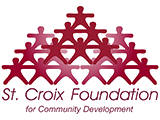Over the past 10 years, St. Croix Foundation has developed partnerships with major education reform organizations like the International Center for Leadership in Education and Grantmakers for Education. Through organizations like these, we continue to learn about innovative, leading edge educational models and best practices that are truly making a difference in struggling school systems around the country. In light of the current state of our own public schools, we believe that some of these educational models could present pathways toward the rapid transformation of our own system. Here are some examples:
Robinson Elementary School
Last year, a local delegation sponsored by the Foundation visited Robinson Elementary, an Apollo 20 program in Houston, Texas. Launched in response to the threat of a state take-over of schools that were failing to make adequate yearly progress, the Houston Independent School District instituted radical changes to the curriculum and organizational structure of 20 public schools. Today, the success that they are achieving can be attributed to new guidelines developed in partnership with Harvard University’s Education Innovation Laboratory, which include the following:
- A mandate from the Superintendent to revise the Administrator Preparatory Curriculum at local universities to focus on training “Turnaround Specialists” in order to build greater capacity in the District’s principal pool
- An extended school day for all 4th beyond the 4th graders in response to data that shows that poor reading skills grade become increasingly difficult to remediate
- Use of university math tutors for all 3rd graders
- A culture of high expectations
At Robinson Elementary, principal and staff are carefully chosen and are given extensive, specialized training in the math and reading programs used in the school. Most impressive is a math program that provides one tutor per four students for 20 minutes each day. With a marked increase in test scores and a proven decline in its dropout rate, Houston is proving that large districts can indeed transform their systems successfully.
New American Academy
The New American Academy started as a pilot project developed and implemented through an unlikely partnership between the New York City teachers’ union and Department of Education and Harvard University. Located in Brooklyn, the New American Academy is a public school model designed from the perspective that student achievement is directly tied to teacher quality. Some key features of New American include:
- Teachers are in a four-step career ladder with a competitive pay scale. Promotion is based on a comprehensive review of competence and ability, not just test scores or seniority.
- Classrooms have teams of four teachers who work with 60-65 students within a grade-level, reducing the teacher to student ratio to 15:1. In addition to a Master Teacher, each team includes licensed Special Education and English Second Language teachers.
- Teacher Teams meet daily in 90 minute sessions to collaborate and engage in peer reviews.
- New American students also ‘loop’ with their classmates and teaching team for five years, with a constant of at least one teacher repeating each year, which allows for the development of trust among students, parents, and teachers.
Harlem Children’s Zone
The Harlem Children’s Zone, founded back in 1970 by renowned educator Geoffrey Canada, has sought to provide a continuum of support services for children from cradle to college. With the ultimate goal of breaking the cycle of poverty, HCZ features comprehensive wrap around social services for children and their families in a 100 block area of Harlem. In recent years, it has been lauded as a national model for its 95% college acceptance rate and for ensuring that 100% of their preschoolers test school-ready. The program consists of:
- A Baby College for parents of children ages 0–3
- All-day pre-kindergarten
- Extended-day charter schools
- Health clinics and community centers for children and adults during after-school, weekend and summer hours
- Youth violence prevention programs
- College admissions and retention support services
These models represent just a handful of 21st Century educational models that the Foundation has toured. What we have learned is that there are no silver bullets! Most reform models are, in many instances, replete with as many challenges as successes. If the Virgin Islands is to finally get serious about the business of educational transformation, we need to determine what pieces of successful models will work for us and which ones won’t. But, in order to do that, we first need to gain an intimate understanding of our system- identifying our assets and liabilities as well as our values– so that we can begin to make informed decisions. This Election Season, we challenge all candidates running for public office to begin really “learning” our system so they can all be active, informed leaders in an educational revolution here in the U.S. Virgin Islands.
Sources
- New American Academy: https://www.thenewamericanacademy.org/
- Robinson Elementary School: https://www.houstonisd.org/robinson
- Harlem Children’s Zone: https://hcz.org/
- International Center for Leadership in Education: https://www.leadered.com/
- Grantmakers for Education: https://www.edfunders.org/our-community/about-gfe
